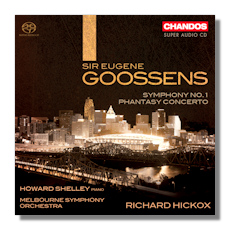
The Internet's Premier Classical Music Source
Related Links
- Latest Reviews
- More Reviews
-
By Composer
-
Collections
DVD & Blu-ray
Books
Concert Reviews
Articles/Interviews
Software
Audio
Search Amazon
Recommended Links
Site News
 SACD Review
SACD Review
Eugene Goossens

- Phantasy Concerto for Piano & Orchestra
- Symphony #1
Howard Shelley, piano
Melbourne Symphony Orchestra/Richard Hickox
Chandos CHSA5068 Hybrid Multichannel SACD
Executive Summary: Mostly well-constructed, conservative late-romantic music, sympathetically performed.
Perhaps best known as a conductor, Eugene Goossens (1893-1962) was also a fine composer. His music rarely soared to the heights of works of the likes Vaughan Williams and Britten, but it had character all of its own. The thematic material is a bit more angular than that of his contemporaries. One does not always come away with a firm sense of a regularity of phrase structure. Notable exceptions on this disc are the slow and scherzo movements of the Symphony. As with much of the music of this period, many stylistic tendencies were "in the air." One can hear the influence of Scott, especially his moving work, "Early One Morning," Bax, Delius and others.
The Phantasy Concerto of 1942 is given its first recording. To my ears it is something of a troubling work. Its constantly shifting tempi and undistinguished thematic material seem to leave it with a bit of a wandering quality. The progression of the compositional rhetoric seems confused, but then again, it is supposed to be a fantasy. The musical argument moves from one section to the next without much of a sense of a logical development of thematic material. A passage of tonal ambiguity is followed by a more conservative lyrical section. Chords seem to have, from time to time, added tones which do not seem to support the overall stylistic considerations. Those tones almost seem like an affectation of a sort, producing some frustration on the part of this listener. One section in the third movement offers a passage accompanied by castanets. Perhaps the only rationale being that the work was written for the Spanish pianist, conductor, Jose Iturbi! That is not to say that music does not have many appealing, reflective moments. According to the program notes, the composer provided a "non-musical genesis" to the work. "The work, particularly the slow movement, was influenced by my rereading at that time of Edgar Allan Poe's The Devil in the Belfry, and might be said to reflect something of the fantastic and sinister character of that story, though in no way being a literal depiction of it." Perhaps Poe's writing made fine sense from a literary perspective: however, it appears to this listener that Goossens' musical manifestation of that idea left something to be desired.
More convincing is the Symphony #1 dating from 1938-40. While the Symphony predates the Concerto by only a year, the Symphony seems to find the composer more at ease with his materials. The work is cast in four movements. It has the sweep of other fine works like the Symphonies of Arthur Benjamin and Ernest Moeran. Some of the angularity in the thematic material is still present but one finds a more clearly defined phrase structure and compositional logic.
The high points of the work are the incredibly lovely slow movement and the delightful third movement, entitled "Divertimento." The slow movement is truly one of the great romantic expressions to be found in British music. The "Divertimento" contains some of the most attractive thematic material of the work. The finale seems a bit over-wrought.
As always, Howard Shelley brings great brilliance to the music. His playing is marked by an abundance of clarity and technical precision. He probably makes the best case possible for the Concerto.
This is, to the best of my knowledge, the third recording of the Symphony. I will give Hickox's reading a place above the others, if for no other reason than his wonderful readings of the second and third movements of the Symphony.
According to the program booklet, this was Hickox's last recording. Listening to the slow movement of the Symphony, one is reminded of what a wonderful gift he gave all of us through his many recordings. While he may not have reached for the last ounce of expression, you can sense a great love and respect for the music in everything he did.
Copyright © 2009, Karl Miller




















